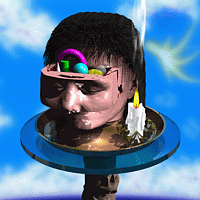Functionally Based Shape Modeling and Computer Art
Authors: A.Sourin, V.Savchenko, A.Pasko

Geometric Mentality (Click on the image to get its 500×500 143K version.)
Designing complex three-dimensional shapes is one of the challenging problems of computer art. This sketch aims to illustrate the application of our approach to complex shape modeling in computer art. Our model, that we have called the function representation , can incorporate very different geometric models such as set-theoretic objects, volume data , swept objects, medial axis and skeleton based implicits. In fact, any object that is defined with an inequality <m>F(x,y,z)>=0</m> can be included in the model. Different solid object metamorphoses and other sophisticated operations are defined as functions superposition. To combine separate objects, we use the exact analytic representations for set-theoretic operations . With this model, a complex scene can be defined as a union of functionally defined objects where, figuratively speaking, the functions are meant as geometric DNAs constituting shapes and properties of the objects.
The image presented in Figure 1 (above) was created using our models and rendered with the modification of the POV-Ray ray tracing program that is able to render implicitly defined surfaces. The scene is described in the POV-Ray script language referring to the functions which implement separate objects.
The central object of the picture, that is a head with a drawer filled with primitive solids, is created by trilinear interpolation of the volume data and set-theoretic operations applied to the head and functionally defined primitives. The hair is modeled with a given number of functionally defined generalized cylinders. Initially, the cylinders are straight and infinite. To make a hairstyle, we applied set-theoretic operations and non-linear transformations to them. The candle holder is modeled as a patterned lattice. It results from the set difference between a hemispherical shell and a swept pattern. The candle is modeled as a cylinder with the top part sculpted by applying a splitting operation to remove the undesirable parts. The candle is then unified with the droplets of wax which are defined by the one-dimensional medial axis model. The table and the tray are created using functionally defined solids. The lizards sitting on the leg of the table are created with the relief carving model using offsetting along the normal. The background with the clouds and the stylized comet are created with scattered data approximation and one- dimensional skeletons respectively.
All these very different models are unified under the platform of the function representation. The authors believe that the function representation will allow computer artists to discover a new source of shapes and operations.
